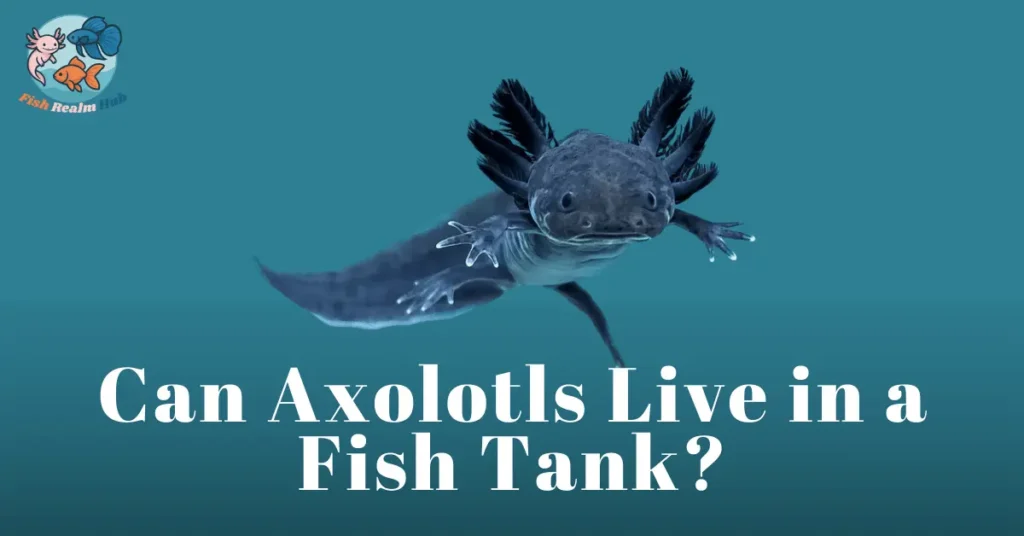If you’re considering keeping an axolotl—also known as the Mexican walking fish—you’ll quickly find they’re one of the most unique and fascinating species of salamanders. Many pet enthusiasts and even scientists have written blog posts explaining how to properly explore their housing requirements.

When I was setting up my axolotl’s fish tank, I realized they have very specific needs for their living environment to stay happy and healthy. These aren’t just regular pets—they need attention and care that goes beyond the usual.
Can Axolotls Live in a Fish Tank – Answer
yes, a fish tank can be a good home, but only if you adjust it to fit what axolotls need. When I was getting my first axolotl, I didn’t know they weren’t like other aquatic pets. After some reading and asking people online, I learned that they are not social animals and don’t enjoy company.
Their soft skin can get hurt or injured by aggressive, rough-playing fish, and they often nip at others. Since axolotls are carnivores, they may eat smaller fish, treating them like a snack. That’s why they aren’t suitable tank mates, and it’s best to keep them in a tank by themselves.
I set up a simple fish tank with hiding spots, soft plants, and gave it a quiet corner to make my axolotl feel relaxed. I’ve never had any fights or missing fish since then. The tank now feels like a cozy home made just for one pet, and it’s been the most peaceful setup I’ve had so far.
What are the Housing Requirements for Axolotls?
Since Axolotls are aquatic animals, they need a clean tank like other aquatic pets, but with specific care. For single axolotls, the minimum tank size should be a 20 Gallon Long, while a 40 Gallon Breeder can house up to three axolotls comfortably.
I always make sure the water stays between 60 and 72 degrees Fahrenheit, and the tank is properly filtered to maintain healthy water quality. Without that, axolotls can get sick fast, so getting the setup right from the start is super important.
What Makes a Good Fish Tank for Axolotls?
A proper fish tank for axolotls needs to follow certain important requirements.
Right Tank Size and Water Volume
For axolotls to swim and explore freely, you need a suitable tank with ample water volume. A tank size of at least 20 gallons and a water depth of 12 inches gives them enough space to stay healthy and happy.
Why Filtration Matters
Good filtration is essential to maintain clean water quality and keep axolotls healthy. A suitable filter should handle the water volume in the tank and be cleaned regularly to avoid problems.
Proper temperature control
Axolotls are sensitive to temperature changes, so it’s important to keep the water in the tank at a constant range between 60 and 68 degrees Fahrenheit. I always use a thermometer to monitor and make sure the proper temperature control is in place.
Appropriate substrate
For axolotls, using an appropriate substrate is key to creating a comfortable environment. I prefer a bare bottom or fine sand as a suitable substrate, but if your axolotl is under 5 inches in length, avoid sand substrate at the bottom of the tank to keep them safe.
What Makes Axolotls Different from Fish
When I first saw an axolotl, I thought it was just a weird-looking fish. But after keeping one, I found out they’re totally different. Axolotls are actually amphibians, not fish, and they’re more like underwater salamanders. They have feathery gills sticking out of their heads, which look super cool, and they don’t have scales like most fish do.
Another thing I noticed is that axolotls like calm, quiet tanks. Unlike fish, they don’t swim around a lot and can get stressed if things move too fast. I had to change how I set up my tank—no strong filters or flashy lights. It’s like giving them their own peaceful space to just float and relax.
Fish Tanks vs. Axolotl Tanks
An axolotl is not a fish—it’s actually an amphibian, like a salamander. It has legs, lungs, and gills, and it stays in water its whole life. A fish, on the other hand, has fins, scales, and only gills to breathe underwater. Unlike most fish, axolotls can regrow body parts, which is pretty cool!
axolotls need more space on the bottom to walk and cooler water than regular fish tanks offer. Fish tanks often have strong filters and bright lights, which stressed my axolotl out until I made a few changes.
the strong water flow and bright light made it hide all the time. I had to add a sponge filter, lower the light, and keep the water cool so it could feel calm and safe.
I didn’t know at first, but keeping my axolotl in a regular fish tank almost made it sick. The strong filter pushed it around, and the warm water wasn’t good for it. Without the right setup, axolotls can get stressed or even stop eating.
Conclusion
When I first got my axolotl, I thought a regular fish tank would be enough. But I soon found out that axolotls need special care—cooler water, low flow, and soft places to hide. Once I made those changes, my axolotl seemed much happier and started eating better too.
Yes, a fish tank can work as a home, but only if you change it to meet your axolotl’s needs. If you’re thinking about getting one, just be ready to modify the tank a bit. It doesn’t take much, but it makes a big difference for their health and comfort.
Faqs
Can axolotls live in a normal fish tank?
I started out using a standard tank because I thought it would be enough for a small axolotl. It seemed okay for young individuals, and a 10-gallon aquarium handled one just fine. But as it grew, I had to move it to a larger setup—at least a 20-long is the minimum for two adults, or even one full-size axolotl. Right size tanks make a big difference in how healthy and calm they stay.
Will axolotls eat my fish?
It might be tempting to add a fish or two into your axolotl tank, but it’s strongly recommended to keep them alone. Since axolotls are carnivorous, they often view smaller fish as food, and that can lead to problems. Plus, some fish may carry diseases or parasites that are harmful to axolotls, even if they look healthy.
What tank should an axolotl be in?
For my axolotl, a long and wide tank worked way better than a tall one. The recommended minimum size is around 60cm by 30cm, but a larger aquarium is ideally more suited for the long term, especially if you’re keeping multiple axolotls together. A comfy aquarium makes all the difference.
What fish can an axolotl live with?
If you really want to keep fish with your axolotl, make sure they’re quarantined first to minimize the risk of spreading infections or diseases. Treating an axolotl is more difficult than treating fish because many chemicals in medicine are toxic to them. Some compatible options like danios, guppies, mosquitofish, rosy red minnows, or white cloud minnows might work—but only with caution.

